
A few years ago, I had the pleasure of meeting a retired professor of Scottish history who, upon noting my Polish name, immediately started talking about Scotland’s long links with Poland, especially the large number of Scots who immigrated to Poland in the 16th and 17th centuries. I found it all extremely interesting but, on my part, I had to admit to complete ignorance. Since then, I asked a few people – both Scots and Poles – about this but their reaction was usually one of surprise, coupled with a good-humoured suggestion that I manage to find Poland everywhere. Did I make this up?
So I was elated when a Scottish friend told me about a new book published by the Edinburgh-based publisher, Birlinn Ltd., titled Scotland and Poland: Historical Encounters, 1500-2010. Five-hundred years of encounters? Could I ask for anything more? I got in touch with them immediately and discovered that Birlinn had more surprises in store for me: a new edition of Ksawery Pruszyński’s 1941 book, Polish Invasion, and Aileen Orr’s delightful book, Wojtek the Bear: Polish War Hero.
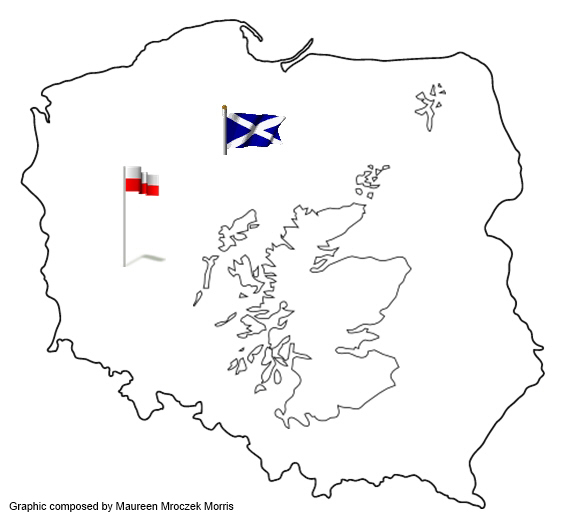 One hardly knows where to start. Perhaps a word about the five centuries of encounters is in order, so that no one will dismiss the idea out of hand as utter nonsense. So before getting into each of the books, it should be pointed out that there were long breaks between encounters. First, the Scottish immigration to Poland in the 16th and 17th centuries; then the “Polish invasion” during WWII; and finally the latest Polish immigration to Scotland beginning in 2004 with Poland’s entry into the European Union.
One hardly knows where to start. Perhaps a word about the five centuries of encounters is in order, so that no one will dismiss the idea out of hand as utter nonsense. So before getting into each of the books, it should be pointed out that there were long breaks between encounters. First, the Scottish immigration to Poland in the 16th and 17th centuries; then the “Polish invasion” during WWII; and finally the latest Polish immigration to Scotland beginning in 2004 with Poland’s entry into the European Union.
The Scottish immigration to Poland ended when emigrating Scots turned their attention to Britain’s expanding empire in America and elsewhere, while Poland’s fortunes fell, after which this history was largely forgotten. By the time the two nations met again, during World War II, they knew nothing about one another. As pointed out in all three books, “the Poles often began by assuming that the Scots were a sort of English… and the Scots in turn by assuming that Poles were a sort of Russian.” Clearly they had a lot to learn but neither spoke the other’s language. In 2004, when the latest cohort arrived, Poles were no longer a mystery and these, mostly young, Poles, often had at least a bit of English at their disposal. Each of these three encounters is filled with surprises and each of these three books tells a fascinating story.
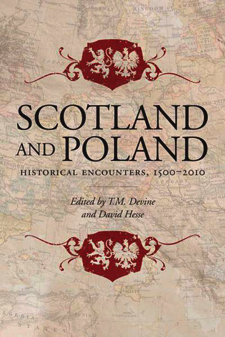 Scotland and Poland: Historical Encounters, 1500-2010
Scotland and Poland: Historical Encounters, 1500-2010
Edited by T.M. Devine and David Hess
Birlinn Ltd, 2011
“Scotland and Poland, Historical Encounters, 1500-2010,” a book inspired by a groundbreaking conference hosted by the University of Edinburgh in October 2009, presents, for the first time in one volume, a survey of Scottish-Polish relations over a period spanning half a millennium. Organized in cooperation with the Polish Cultural Institute in London and the Consulate General of the Republic of Poland in Edinburgh, the conference brought together scholars from Scotland, England, Australia and Poland, all of them specialists in the little-known area of Scottish-Polish relations.
The opening paper was presented by the well-known journalist and highly regarded authority on Poland, and one can say also a great friend of Poland, Neal Ascherson, who began by paying homage to a man he considers a symbol of the Scottish-Polish relationship: General Stanisław Maczek, a great soldier and liberator of cities in France and Holland. As already noted, most Scots knew nothing about Poland in 1940 but they can be forgiven for being parochial at a time when few people travelled beyond their parishes. Still, one didn’t expect this from someone of the rank of Field-Marshall Montgomery who, upon meeting General Maczek in 1940, asked him: “Tell me, what language do Poles really speak among themselves at home – German or Russian?”
Amusing as that is, “Scotland and Poland” has a much bigger story to tell and Professor Ascherson leads with a marvelous overview of the Scottish settlers in Poland that might have numbered 30,000 or more, though the precise number can’t be determined. Indeed, it was noted that when the English parliament was debating union with Scotland (1707), those not in favour pointed to Poland as a warning: “If we admit them into our liberties we shall be overrun with them… witness the multiplicities of the Scots in Poland.”
At a time when Europe was engulfed in religious strife, the uniquely tolerant Polish-Lithuanian Commonwealth accepted the Scots, whatever their religion, since both Catholics and Protestants had, at various times, good reason to get away from bigotry and violence in their homeland. Treated well by the Crown, they were largely successful merchants and bankers, one of them, Alexander Chalmers (Czamer), a four-term mayor of Warsaw, another, William Bruce, a professor of Roman Law at the new university at Zamość. Bruce and others, notably Patrick Gordon, an associate of Jerzy Sebastian Lubomirski, wrote well-informed and detailed accounts of Polish politics. The Scots established well organized settlements, divided into twelve “Scottish Brotherhoods” each with elected elders who came together annually in Torun. At times there was friction, as in one deadly act of anti-Scot violence in Torun, but the Crown defended the Protestant minority.
This period of Scottish emigration is also important in the history of the Scottish diaspora since it was during the Polish phase that the Scots developed their “specific model of emigration of small patriarchal units usually recruited through family connections.” This “enlightened nepotism” eventually developed into private partnerships that spread across the British Empire in the 18th and 19th centuries and survived into the giant private trading companies such as Guthries and Jardine Matheson. Scottish emigrants also ploughed their profits back into the local economies, in Poland, for example, investing heavily in linen factories.
The section by Robert Frost, a professor at the University of Aberdeen, is particularly interesting in that he not only discusses the Commonwealth but also the lack of interest, misunderstanding and even disinformation about it despite the very real parallels between Polish and Scottish political history. The Counter-reformation in Poland led by the Jesuits dimmed the Scots’ interest in Polish religious traditions including its record of toleration, and “from the early seventeenth century, Poland was classed among the Catholic powers, and linked therefore to a stereotype of absolute monarchy and arbitrary power, despite the fact that the Catholic hierarchy in Poland, while broadly monarchical in its sympathies, was by no means a supporter of absolute royal power; ironically Catholic Poland-Lithuania had remained true to the Roman republican and Ciceronian tradition that had so influenced Scottish Calvinist political discourse in the sixteenth century.”
Waldemar Kowalski, professor of history at the Jan Kochanowski University in Kielce, discusses the reasons for Scottish emigration and also their reception in Poland, which, he says, was not always welcoming. Immigration history is replete with accounts of prejudice, contempt for the poor (the peddlers with packs on their backs) and resentment of the successful (the bankers and wealthy merchants), especially when religious differences could be exploited.
In a second paper by Professor Frost, comparing the rural economies of the Scottish Highlands and the Polish-Lithuanian Commonwealth, he challenges the black and white legends that have dominated western views of the two countries. With the disappearance of the Polish state under the partitions, few scholars studied Polish political and social history creating a vacuum easily filled by ill-informed statements often in the service of the established powers. The long period of Soviet domination after WWII imposed a strong grip of censorship over this already neglected subject. The fall of communism finally liberated Polish historians from paying lip service to the simplistic views so long impeding independent research. There is a renewed interest in this field.
With each paper, “Scotland and Poland” provides a new dimension, a new insight and a new perspective, served up by an impressive group of historians gathered in Edinburgh for this conference.
Subjects covered include a Scottish diplomat representing England; women in a Scottish Reformed Parish in Cracow (Agnes Burnet:Agnieszka Bornatowa, Ursula Elmslie:Emslowa, Anna Hewison:Huison); wealthy family networks and ennobled Scots: a rich and colourful pageant.
As the papers move on to more recent history, it returns to the heroism and the horror of the war, the loss of home, and the change in attitudes as soldiers become workers in need of jobs. There are religious tensions: most Poles are Catholics, most Scots are not. There is the emotional impact of Yalta and Potsdam, followed by the UK Labour Government’s and the unions’ vilification of their former allies along with blind admiration of the Soviet Union, Gulag and all.
But in the end, the Poles who stayed did well and came to love Scotland and Scots accepted them, no doubt a good thing for the most recent arrivals in this century. A survey of media attention to the new immigrants paints largely a positive picture, celebrating the Poles for helping with two specific issues: population decline and a skills shortage. In the 1940s, the press urged England to take a greater share of the Polish exiles; this time the press urges the Poles to choose Scotland over England. But the media is fickle, so the report suggests the media be observed “through a wary lens.”
Contributors to “Scotland and Poland” include Alan Carswell, an authority on British Military history; Rachel Clements of Newcastle University; T.M. Devine, a professor of Scottish history and Director of the Scottish Centre of Diaspora Studies; David Hesse of the University of Edinburgh, Anna Kalinowska of the Institute of History, Polish Academy of Science in Warsaw; Peter Stachura of the University of Stirling; David Worthington from the UHI Millennium Institute, soon to be the University of the Highlands and the Islands; and Aleksander Dietkow from the Ministry of Foreign Affairs in Poland.
“Scotland and Poland” is so fresh, new and invigorating that it’s a must for every university library – and a pleasure for anyone interested in history, Polish, Scottish or just diaspora history. What a conference it must have been. A model, one hopes, for similar ventures perhaps? What a pleasure it would be to have several sessions at a PIASA conference on Poles and Tatars, Poles and Armenians, Poles and Italy… and, of course, Poles and Scots.
Polish Invasion
By Ksawery Pruszyński, translated by Peter Jordan
Birlinn Ltd, 2009
Could one say about the years that Polish soldiers spent in Scotland: they were the best of times, they were the worst of times?
Ksawery Pruszyński’s book, “Polish Invasion,” first published in 1941, is so amusing, so lighthearted that yes, you are tempted to say, “Yes, it was a terrible war but oh, what wonderful times we had.” It’s an entertaining book, fast paced, with marvelous characters. So why does it leave you so sad?
Because Pruszyński was a gifted writer, because he wrote with feeling and with a purpose and, perhaps most of all, because he wrote the book long before the war ended.
Sometimes known as a “radical” journalist, Pruszyński was, above all, a very independent journalist. After the fall of Poland in October 1939, he, along with thousands of others, trekked across Europe to join Polish forces determined to regroup and continue fighting Nazi Germany. He saw action in Norway and then spent several years in Britain until he once again fought in Europe, this time landing in Normandy with the Allies and taking part in the battle at Falaise.
He wrote “Polish Invasion” while in Scotland with the other Polish soldiers sent there to train and to defend Scotland in case of a German attack. While there, his keen eye, deft use of dialogue and marvelous imagination created this witty, clever, insightful and tender story of the early stages of this Polish-Scottish encounter.
The story is told largely through a conversation among several officers including a general, a colonel and a major as well as a Scottish officer who was a historian in civilian life and whose role was to explain Poles and Scots to one another. Pruszyński’s officers could almost fit into a Gilbert and Sullivan operetta except that you never forget that the humour is always just the highly polished veneer on a serious story.
The historian and the officers are sometimes joined by the clergy, who also have their views on Polish-Scottish differences, albeit more from a Protestant-Catholic perspective. Despite the clergy’s anxieties, the soldiers seem to care little about all this and are quite prepared to find romance with Scottish girls who, having lived only with Calvinists, had never met men who could “dance like Fred Astaire.”
It’s a delightful book, as amusing as it is instructive about the Polish-Scottish past as well as about their encounter in 1940. It also illustrates the essential human bond between people everywhere despite different social, cultural, national and religious differences though it requires some effort and a lot of good will to establish communications.
It is the end of the story that tugs at the heartstrings the most. When Pruszyński wrote this, he clearly believed that, despite the grave danger, ultimately the allies would win the war and Poles would return home. He imagined a wonderful scene, one in which the grateful Poles would invite their Scottish hosts to come and visit them, to see their country, taste their food, dance and sing their songs, and enjoy their hospitality. He didn’t know then how all this would end. We do.
The translation, which I assume is the original translation of 1941, is bright, lively and not at all stilted. Neal Ascherson provides his usual excellent historical background. But it is Pruszyński’s book, and it comes as no surprise that, decades, later Ryszard Kapuściński credited him with being a major influence and even inspiration. Both journalists write with that wonderful combination of keen observation, psychological insight and imagination. It’s a delightful book, well worth the tear or two that might be shed at the end.
Wojtek the Bear: Polish War Hero
By Aileen Orr
Epilogue by Neal Ascherson
Sept. 1, 2010
No doubt all Poles know, as by now many others must as well, that despite the fact that Polish forces fought with Britain in virtually every theatre of war against Nazi Germany, the Poles were barred from marching in London’s great victory parade. This was not England’s finest hour.
On the other hand, very few people, Poles included, know that in 1946 the people of Glasgow staged a ticker tape parade and lined the streets of the city to welcome Polish veterans. Proudly marching in the ranks was Private Wojtek, a Syrian brown bear who had, by this time, been with the Polish army for 26 months, traveling through the Middle East, crossing with them to Italy where he saw action at Monte Cassino, and then continuing on to liberate Ancona and Bologna. He was a genuine war hero, loved and respected by his comrades, and well on the way to winning the hearts of the Scots.
A number of books have appeared about Wojtek but it is really the internet that has spread his fame worldwide. Clips from archival Polish army footage are posted on YouTube, and in the past couple of years his story has made the news on every continent. One Italian headline read: Wojtek l’orso che libero l’Italia (Wojtek, the bear that liberated Italy).
Still, these clips only tell a tiny bit of the story and his most ardent admirers – apart from his old comrades – are Scots, particularly one Scot who believes Wojtek deserves much more recognition and has taken steps to ensure this happens.
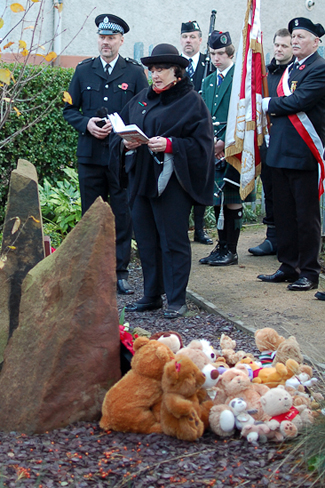 Aileen Orr (pictured at right), the author of “Wojtek the Bear: Polish War Hero” and a member of the Scottish Parliament, not only wrote a book about him but also established the Wojtek Memorial Trust to honour Wojtek and the men who traveled with him from Iran to Scotland during World War II, and to strengthen the bonds between Scotland and Poland. Trustees include Cardinal Keith O’Brien, Major General Euan Louden, Krystyna Szumelukowa and Mrs. Orr.
Aileen Orr (pictured at right), the author of “Wojtek the Bear: Polish War Hero” and a member of the Scottish Parliament, not only wrote a book about him but also established the Wojtek Memorial Trust to honour Wojtek and the men who traveled with him from Iran to Scotland during World War II, and to strengthen the bonds between Scotland and Poland. Trustees include Cardinal Keith O’Brien, Major General Euan Louden, Krystyna Szumelukowa and Mrs. Orr.
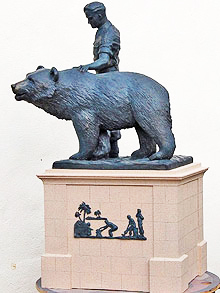 Ms. Orr’s plans include a statue of Wojtek (pictured at left) walking together with his best friend, Peter Prendys, a sergeant in the army of General Anders. Although the best known image of Wojtek showed him carrying shells, the sculptor, Alan Herriot, chose to emphasize the strong bond between the soldiers and their much loved bear.
Ms. Orr’s plans include a statue of Wojtek (pictured at left) walking together with his best friend, Peter Prendys, a sergeant in the army of General Anders. Although the best known image of Wojtek showed him carrying shells, the sculptor, Alan Herriot, chose to emphasize the strong bond between the soldiers and their much loved bear.
To tell the story, Ms. Orr researched archival materials and interviewed many people who remember Wojtek. She herself met Wojtek when she was eight, during a school trip to the Edinburgh Zoo, Wojtek’s last home. Her grandfather, who had been a sergeant in the proud and distinguished regiment, the King’s Own Scottish Borderers, was a regular visitor to the camp at Winfield in Scotland. He told Aileen to say “hello” to Wojtek in Polish, and Wojtek’s spontaneous response, making eye contact and waving his paw, won her heart and created an indelible memory.
The book tells so many stories, tender, sad and funny: how the soldiers got the cub, how they concealed him from the NCO who, in turn, concealed him from the officers who, in turn, instantly approved. Ms. Orr recounts Wojtek’s many adventures – in the Middle East, in Italy and finally in Scotland. Like all soldiers, he liked an occasional beer and a cigarette, loved food, loved to wrestle, and was always willing to help carry heavy objects. In Scotland, his comrades took him along to dances in the nearby small towns and he was, of course, a girl magnet. The image of Wojtek sitting upright at a dance, head swaying to the music, is one that nobody could ever have forgotten. In 1947, the Polish army was demobilized and the soldiers scattered across the UK to embark on their civilian lives. That included Private Wojtek, whose job qualifications in civilian life were quite limited. Finally it was decided the Edinburgh Zoo was the best place, not least because they accepted him with great pleasure. For a long time, Polish soldiers visited Wojtek and, despite Zoo regulations, often jumped over the barrier to enjoy a playful wrestle with their old friend. But the zoo authorities didn’t stop them, knowing it made Wojtek happy – and was highly entertaining for visitors.
There is much more, all of it beautifully told. Neal Ascherson once again fills in the historical background in an excellent epilogue. This is a book that tells a sad and inspiring story in the most heartwarming way possible, bound to please those who know the history and an excellent introduction for those who don’t. And funds from the book will go to Wojtek’s Memorial Trust.
For more about Wojtek and his Scottish friends, here is a link to the Robert Owen Memorial Primary School’s children singing “Voytek the Soldier Bear,” with music by Billy Stewart. The school is in Lanarkshire, Scotland.
And here’s a link to Aileen Orr speaking at a memorial service.
CR
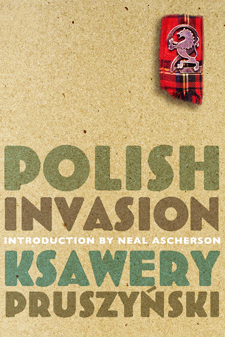
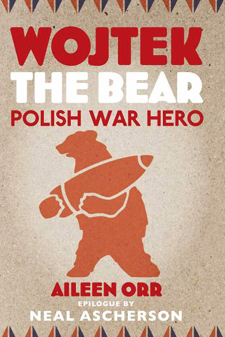
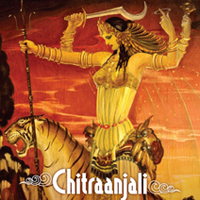

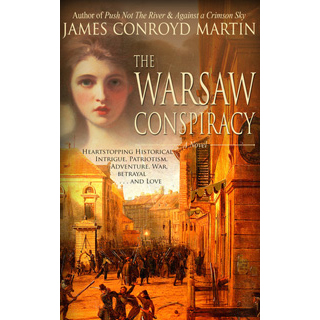

Pingback: Ethnic groups of Polish Late Medieval cities - Historum - History Forums